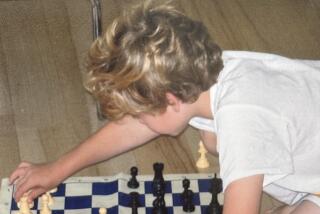A sweeping question for colleges that embrace quidditch
There’s plenty of action on the field as two teams scuttle about, chucking balls and driving for the hoop. But it’s clear this sport is a little different. For one, the most important part of the game is way on the other side of a hill, perched high in a tree.
He’s wearing a bright yellow jersey and a sly smirk, and carries a rubber ball in a sock hanging like a tail from the back of his pants. Circling beneath him, like sharks, is a player from each team, straddling the brooms this game requires.
They are the seekers. The one they’re hunting in the tree is the snitch. Catching him is the only way to end the game.
For college students who secretly ranked Hogwarts as their first-choice school, this is how quidditch is played.
The sport — and its players want you to know, it is a sport however foolish it may appear — has spread to college campuses across the country in recent years, appealing to a generation that grew up with Harry Potter, his band of magical misfits and the high-flying game at which he excelled.
Quidditch was adapted by a group of students at Middlebury College in 2005 as a ground game that required only a field, a few varieties of balls and, of course, a broom for each player.
Since then, hundreds of American colleges have started quidditch teams, said Alex Benepe, commissioner of the International Quidditch Assn., the governing body that grew out of the ragtag team at the Vermont liberal arts college. Several Southern California schools have teams: Students at UCLA and USC have played for about a year; Occidental College in Eagle Rock has had a team for three years.
As it takes off, though, quidditch and its players have to figure out what the game ought to be. Should it be eternally tied to Harry Potter, remaining a niche sport for fans of the wizarding books? Or should it become a legitimate sport, outgrowing its roots?
Perhaps, quidditch can be both.
With help from the International Quidditch Assn., UCLA recently organized the Western regional cup in Los Angeles, said to be the largest quidditch tournament to take place west of the Mississippi. Eleven teams competed at the event at a park in Cheviot Hills on the Westside.
It seemed appropriate that finding the tournament required crossing through the bustling park to a tucked-away field surrounded by knobby-trunked trees the shape of magical broomsticks. Vendors had set up a miniature “Diagon Alley” — like the magical shopping street frequented by Harry and his friends — where they hawked robes, books and witty T-shirts (one read: “99 problems but a snitch ain’t one”).
Some team members appeared to be bookish Harry Potter fans, slightly sluggish as they ran around the field, with a few wearing cloaks and capes. Others carried themselves like trained athletes, lithe and quick-footed.
A game of quidditch looks like a haphazard merger of basketball, dodge ball and rugby, with the chase between the seeker and the snitch adding a measure of hide-and-seek. It consists of two balls — the quaffle for scoring and the bludger for throwing at opponents like a dodge ball. The snitch — in the magical version, a hummingbird of a ball with a mind of its own— is a neutral player who has to be one part sprinter, another part showman.
“Harry Potter isn’t the only draw to the sport,” said Spencer Gold, the captain of USC’s team. “If you can convey the awesomeness of quidditch, they can buy into it.”
Sebastian Milla, a sophomore at UCLA, described the game as “the aggressive sport I never got to play as a kid.” (His mom nixed his childhood hopes of playing football.)
“It may look like a bunch of kids running on brooms,” added Milla, 20, who helped start UCLA’s team about a year ago. “There’s strategy that goes into the game.”
But Milla noted that quidditch here is still in its infancy compared with many East Coast schools where it is a recognized club sport, teams have detailed strategies on the field and they actively recruit players. “On the West Coast, it’s still an amateur sport,” he said, “and we’re going to keep owning that as long as we can.”
The more relaxed competition at West Coast colleges means there’s room for less-than-stellar athletes to play and makes for a game that can be more fun. Yet it also means they don’t get much respect.
Many quidditch teams struggle as they vie for recognition, and funding, from their schools. At Occidental, for instance, where quidditch has been played for several years, its status as a club sport is still pending.
It’s just one of many unusual hurdles these students face as they try to bring the sport to their campuses.
When USC’s team started, for example, Gold, 19, wasn’t sure where to find brooms that weren’t too long. At UCLA, Milla worried that playing such an off-the-wall game would hinder whatever chances he had with women. (The fact that school administrators required them to wear protective goggles because of the broomsticks didn’t help.)
Occidental student Emily Ritchie had seen the game played at Middlebury and was eager to start a team. But no one came to her first organizing meeting. That soon changed, although she said it’s been difficult to introduce people to a sport they often view as more akin to “Dungeons and Dragons” than touch football on the quad.
“I had to convince people it was cool to play,” the 22-year-old senior said.
“And that it’s real,” added Craig Kaplan, also 22, as he and Ritchie packed up at the end of the recent tournament. The Occidental senior had just played what was probably his final game of quidditch in college, or perhaps forever.
But he can always remember that he caught the snitch.
More to Read
Sign up for Essential California
The most important California stories and recommendations in your inbox every morning.
You may occasionally receive promotional content from the Los Angeles Times.










